
Eyecare company Bausch + Lomb (NYSE: BLCO) reported revenue ahead of Wall Street’s expectations in Q4 CY2024, with sales up 9.1% year on year to $1.28 billion. On the other hand, the company’s full-year revenue guidance of $4.98 billion at the midpoint came in 1.1% below analysts’ estimates. Its non-GAAP profit of $0.25 per share was 6.9% above analysts’ consensus estimates.
Is now the time to buy Bausch + Lomb? Find out by accessing our full research report, it’s free.
Bausch + Lomb (BLCO) Q4 CY2024 Highlights:
- Revenue: $1.28 billion vs analyst estimates of $1.26 billion (9.1% year-on-year growth, 1.8% beat)
- Adjusted EPS: $0.25 vs analyst estimates of $0.23 (6.9% beat)
- Adjusted EBITDA: $259 million vs analyst estimates of $257.7 million (20.2% margin, 0.5% beat)
- Management’s revenue guidance for the upcoming financial year 2025 is $4.98 billion at the midpoint, missing analyst estimates by 1.1% and implying 3.8% growth (vs 15.9% in FY2024)
- EBITDA guidance for the upcoming financial year 2025 is $925 million at the midpoint, below analyst estimates of $952 million
- Operating Margin: 6.8%, up from 4.2% in the same quarter last year
- Constant Currency Revenue rose 11% year on year (19% in the same quarter last year)
- Market Capitalization: $5.79 billion
“Underpinning our recent success is a commitment to long-term, profitable growth,” said Brent Saunders, Chairman and CEO, Bausch + Lomb.
Company Overview
Founded in 1853, Bausch + Lomb (NYSE: BLCO) is a global healthcare company specializing in eye health products, including contact lenses, lens care products, surgical instruments, and pharmaceuticals for ocular conditions.
Medical Devices & Supplies - Specialty
The medical devices industry operates a business model that balances steady demand with significant investments in innovation and regulatory compliance. The industry benefits from recurring revenue streams tied to consumables, maintenance services, and incremental upgrades to the latest technologies, although specialty devices are more niche. The capital-intensive nature of product development, coupled with lengthy regulatory pathways and the need for clinical validation, can weigh on profitability and timelines. In addition, there are constant pricing pressures from healthcare systems and insurers maximizing cost efficiency. Over the next several years, one tailwind is demographic–aging populations means rising chronic disease rates that drive greater demand for medical interventions and monitoring solutions. Advances in digital health, such as remote patient monitoring and smart devices, are also expected to unlock new demand by shortening upgrade cycles. On the other hand, the industry faces headwinds from pricing and reimbursement pressures as healthcare providers increasingly adopt value-based care models. Additionally, the integration of cybersecurity for connected devices adds further risk and complexity for device manufacturers.
Sales Growth
Examining a company’s long-term performance can provide clues about its quality. Any business can put up a good quarter or two, but the best consistently grow over the long haul. Over the last five years, Bausch + Lomb grew its sales at a mediocre 5% compounded annual growth rate. This was below our standard for the healthcare sector and is a tough starting point for our analysis.
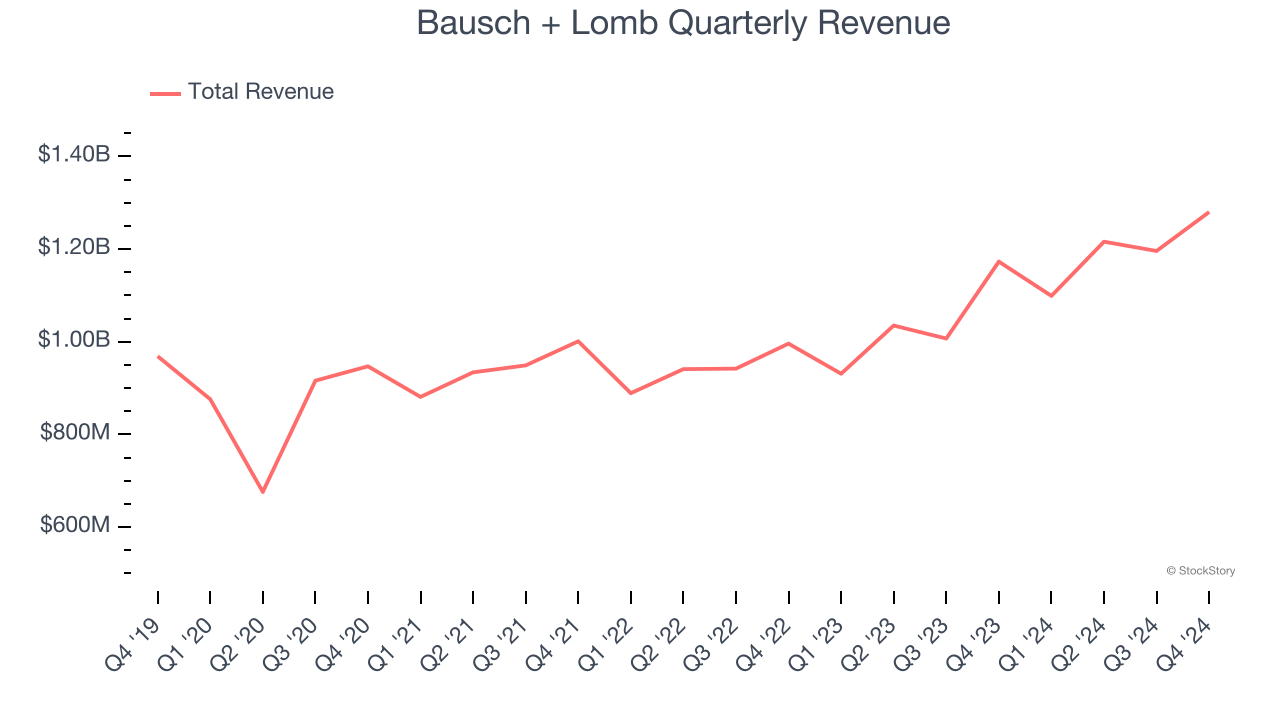
Long-term growth is the most important, but within healthcare, a half-decade historical view may miss new innovations or demand cycles. Bausch + Lomb’s annualized revenue growth of 12.8% over the last two years is above its five-year trend, suggesting its demand recently accelerated. 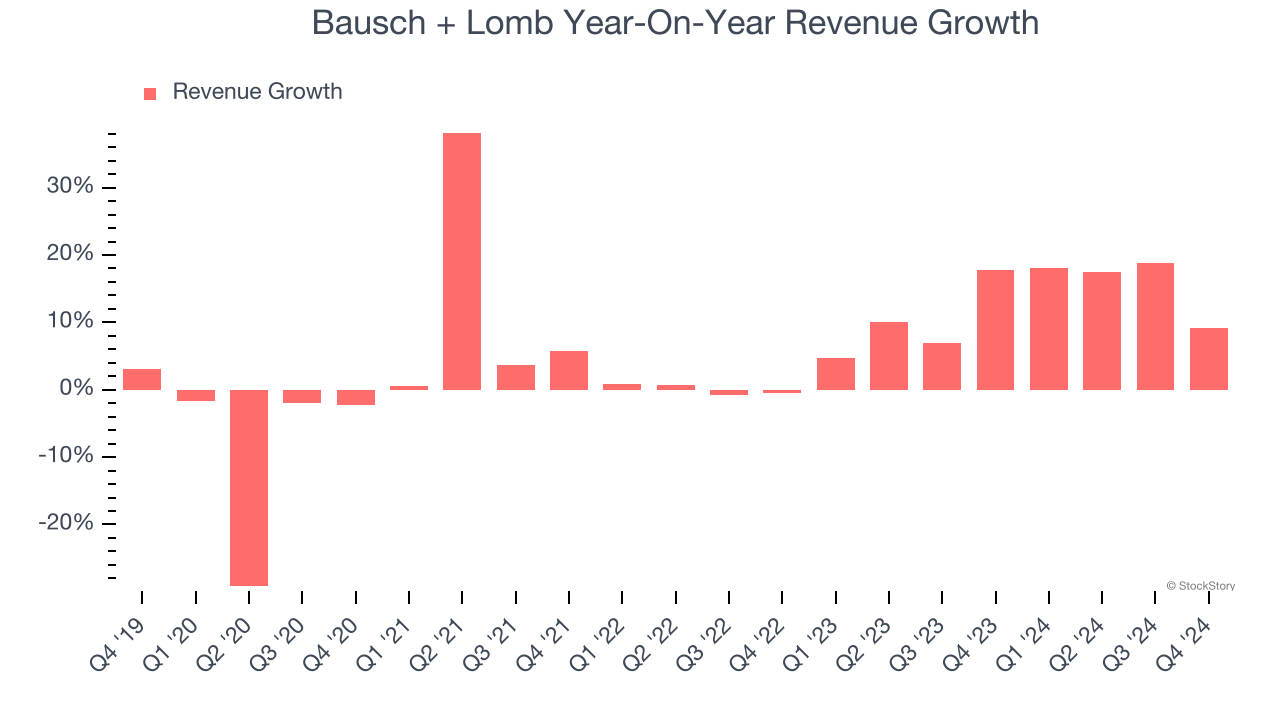
Bausch + Lomb also reports sales performance excluding currency movements, which are outside the company’s control and not indicative of demand. Over the last two years, its constant currency sales averaged 14.7% year-on-year growth. Because this number is better than its normal revenue growth, we can see that foreign exchange rates have been a headwind for Bausch + Lomb. 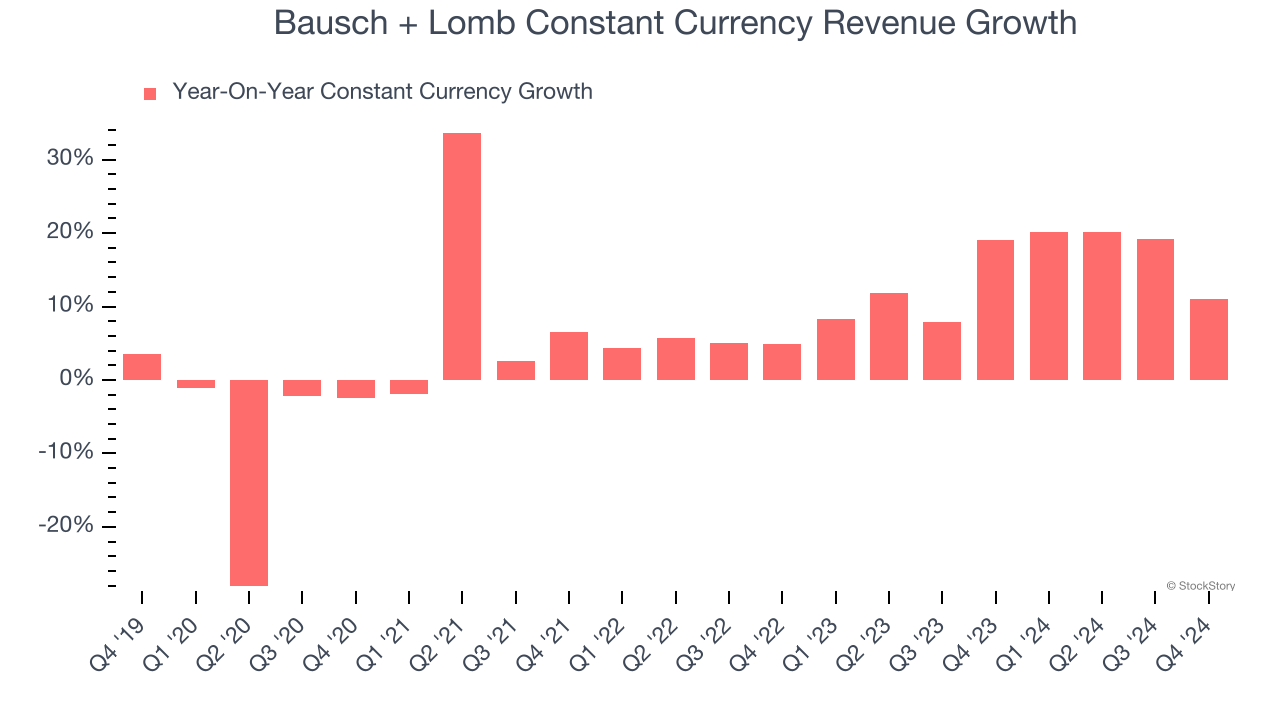
This quarter, Bausch + Lomb reported year-on-year revenue growth of 9.1%, and its $1.28 billion of revenue exceeded Wall Street’s estimates by 1.8%.
Looking ahead, sell-side analysts expect revenue to grow 4.3% over the next 12 months, a deceleration versus the last two years. This projection is underwhelming and suggests its products and services will see some demand headwinds.
Unless you’ve been living under a rock, it should be obvious by now that generative AI is going to have a huge impact on how large corporations do business. While Nvidia and AMD are trading close to all-time highs, we prefer a lesser-known (but still profitable) stock benefiting from the rise of AI. Click here to access our free report one of our favorites growth stories.
Operating Margin
Operating margin is an important measure of profitability as it shows the portion of revenue left after accounting for all core expenses – everything from the cost of goods sold to advertising and wages. It’s also useful for comparing profitability across companies with different levels of debt and tax rates because it excludes interest and taxes.
Bausch + Lomb was profitable over the last five years but held back by its large cost base. Its average operating margin of 5.9% was weak for a healthcare business.
Analyzing the trend in its profitability, Bausch + Lomb’s operating margin decreased by 6.5 percentage points over the last five years. The company’s two-year trajectory also shows it failed to get its profitability back to the peak as its margin fell by 2.1 percentage points. This performance was poor no matter how you look at it - it shows its expenses were rising and it couldn’t pass those costs onto its customers.
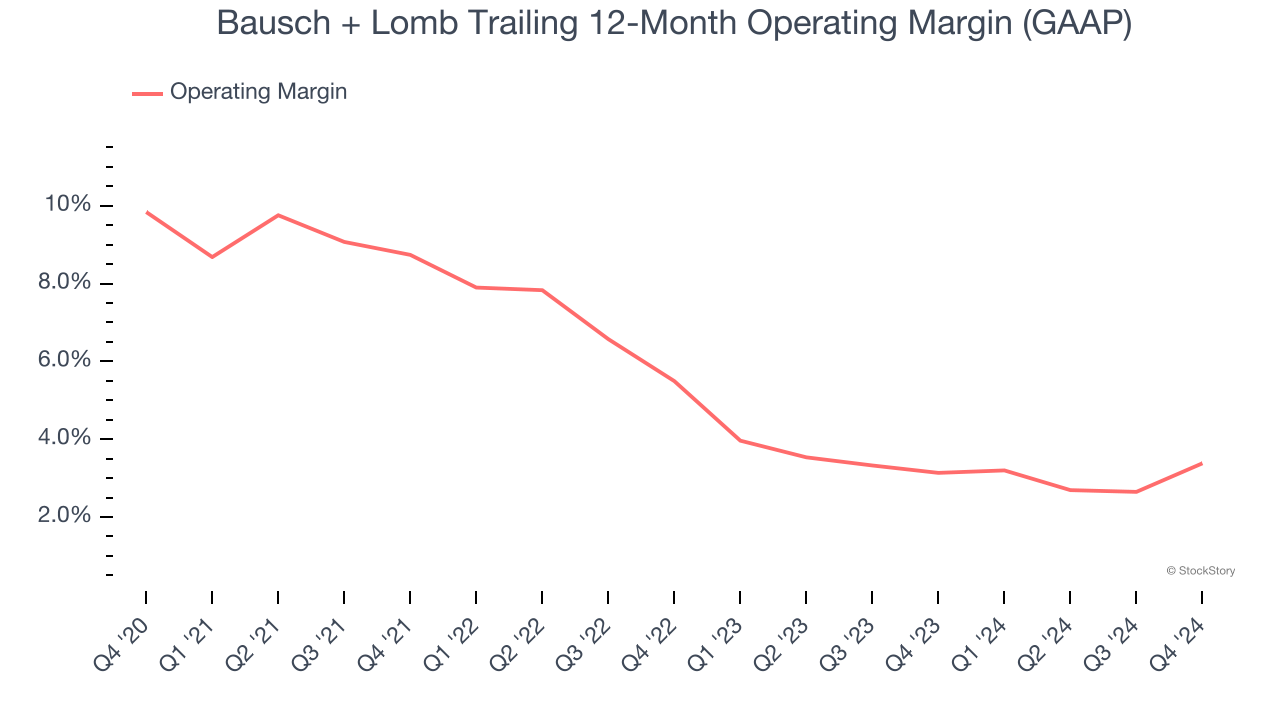
This quarter, Bausch + Lomb generated an operating profit margin of 6.8%, up 2.6 percentage points year on year. This increase was a welcome development and shows it was recently more efficient because its expenses grew slower than its revenue.
Earnings Per Share
We track the long-term change in earnings per share (EPS) for the same reason as long-term revenue growth. Compared to revenue, however, EPS highlights whether a company’s growth is profitable.
Sadly for Bausch + Lomb, its EPS declined by 23.7% annually over the last five years while its revenue grew by 5%. This tells us the company became less profitable on a per-share basis as it expanded.
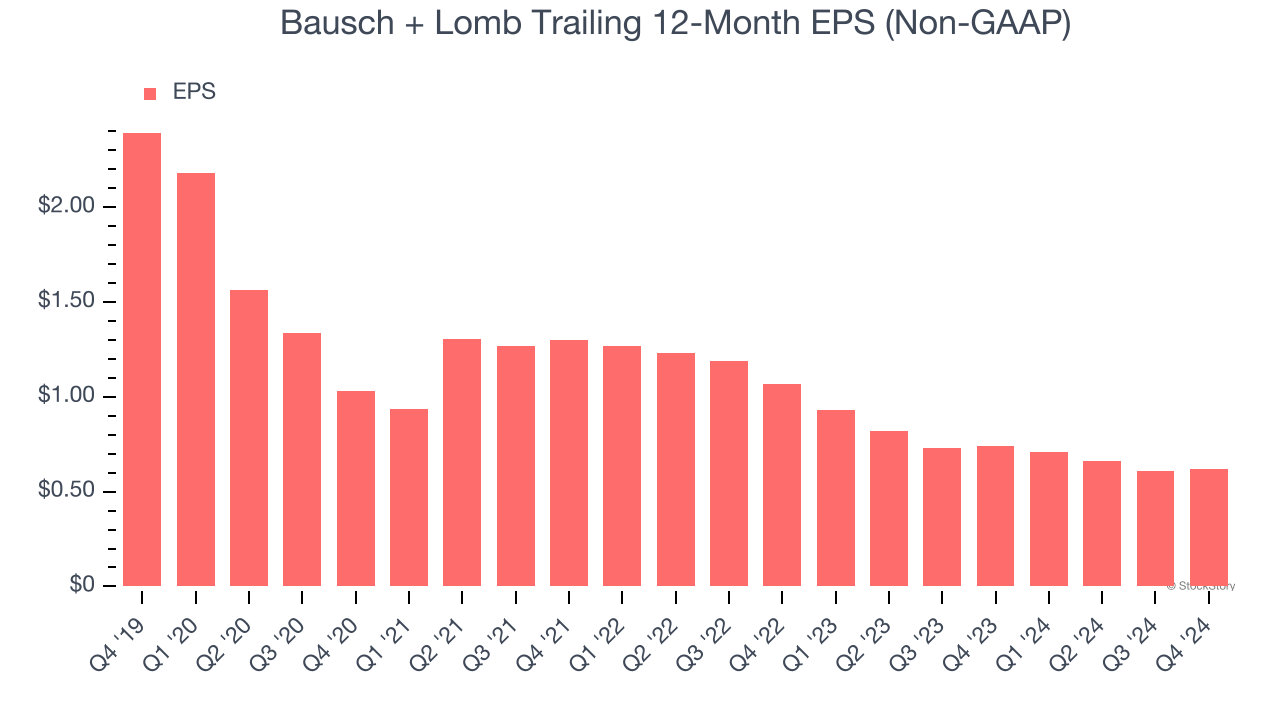
We can take a deeper look into Bausch + Lomb’s earnings to better understand the drivers of its performance. As we mentioned earlier, Bausch + Lomb’s operating margin improved this quarter but declined by 6.5 percentage points over the last five years. This was the most relevant factor (aside from the revenue impact) behind its lower earnings; taxes and interest expenses can also affect EPS but don’t tell us as much about a company’s fundamentals.
In Q4, Bausch + Lomb reported EPS at $0.25, up from $0.24 in the same quarter last year. This print beat analysts’ estimates by 6.9%. Over the next 12 months, Wall Street expects Bausch + Lomb’s full-year EPS of $0.62 to grow 24.4%.
Key Takeaways from Bausch + Lomb’s Q4 Results
It was good to see Bausch + Lomb narrowly top analysts’ constant currency revenue and EBITDA expectations this quarter. We were also happy its EPS outperformed Wall Street’s estimates. On the other hand, its full-year revenue and EBITDA guidance fell short. Overall, the outlook could have been better. The stock traded up 2.8% to $16.80 immediately following the results.
Big picture, is Bausch + Lomb a buy here and now? What happened in the latest quarter matters, but not as much as longer-term business quality and valuation, when deciding whether to invest in this stock. We cover that in our actionable full research report which you can read here, it’s free.
